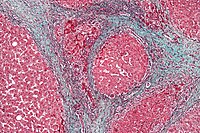
Photo from wikipedia
Post-ischemic acute tubular necrosis is a common cause of acute kidney disease (AKD) and subsequent chronic kidney disease. In AKD, mononuclear phagocytes (MPCs) including conventional dendritic cells (cDCs) are present… Click to show full abstract
Post-ischemic acute tubular necrosis is a common cause of acute kidney disease (AKD) and subsequent chronic kidney disease. In AKD, mononuclear phagocytes (MPCs) including conventional dendritic cells (cDCs) are present during the different phases of kidney injury, repair and regeneration. The contribution of cDCs to AKD is still poorly understood. Hence, we hypothesized that transcription factor interferon regulatory factor 8 (IRF8)-specific cDCs regulate the immune response in AKD. AKD was induced by unilateral ischemia reperfusion injury in IRF8-deficient Clec9a-specific DCs (IRF8fl/fl Clec9acre/cre or cre/wt) and wild type C57BL/6 mice. Immune phenotyping of leukocytes in kidney and spleen and mRNA expression profiling were performed, as well as kidney function evaluated. For in vitro studies, IRF8 small interfering RNA transfection technology on bone marrow-derived DCs was used. In the healthy kidney and lymphoid organ (e.g., spleen and kidney draining lymph node), we identified four MPC subsets according to the diverse expression patterns of CD11b and CD11c. Of which, IRF8 was specifically expressed in the CD11blow CD11chigh R4 subset (containing mainly cDC1). During AKD, IRF8 deficiency in cDCs reduced the number of MHCII+ DCs accumulating among tubulointerstium space without affecting cDC2 or CD64+ DCs, while completely abolished cDC1 in post-ischemic kidney (See Figure). This was accompanied with a decrease in the surface expression of chemokine receptor CCR7 and CCR9, reduction in the number of kidney CD4- CD8+ T cells and Tregs, but a moderate increase in TH1-related and pro-inflammatory cytokines and infiltrating neutrophils in the kidney of mice with IRF8-deficient cDCs. This was in line with reduced kidney function, marked by aggravated GFR loss, elevated plasma BUN level, kidney atrophy, pathological tubular injury and living proximal tubule loss. In vitro, bone marrow-derived IRF8-deficient DCs showed an impaired ability to repair “artificially injured” tubular epithelial cells (TECs), accompanied with less phagocytosis capacity and maturation capacity under necrotic TECs soup or histone stimulation. Our data show that the restricted depletion of IRF8 in cDCs reduces the number of infiltrating kidney cDC1, which drives tissue inflammation and damage, and ultimately aggravates post-ischemic AKD. Thus, cDC1s are having a protective role in AKD.
Journal Title: Nephrology Dialysis Transplantation
Year Published: 2021
Link to full text (if available)
Share on Social Media: Sign Up to like & get
recommendations!